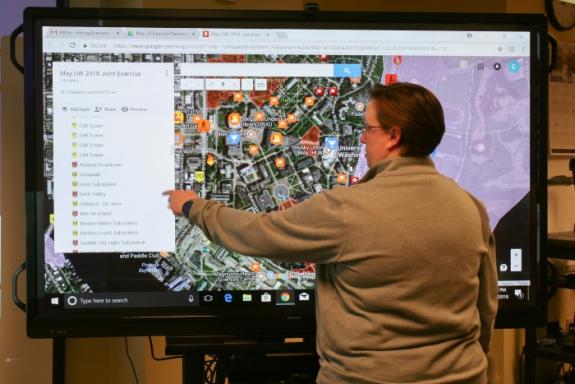Planning for disaster

Reflective vests for department representatives draped on chairs
Athletes aren’t the only ones training for this summer’s Special Olympics in Seattle. Deep beneath UW Tower on May 22, more than 100 University of Washington personnel and regional partners will gather for a simulated disaster — testing and evaluating the University’s ability to handle a large-scale emergency.
The UW Emergency Operations Center runs similar exercises annually, but with 90,000 volunteers, family members, friends and spectators expecting to attend Special Olympics events across the city, including at UW venues, the scale is bigger this year.
“One of the biggest challenges is the amount of jurisdictions, agencies and non-profits that are involved,” said Eli King of UW Emergency Management. King is the plans, training, exercise & EOC operations manager and her team has been working for 18 months on the necessary coordinated emergency procedures. The exercise is a chance to see how they will work.
Participants aren’t told the details of the simulated disaster until the exercise starts. The idea is to see how well University staff and systems react in a real-time environment. Last year’s exercise involved a hypothetical communicable disease on the UW Seattle Campus and how that would impact UW Seattle, UW Tacoma and UW Bothell, as well as coordination with the City of Seattle and regional public health agencies.
“While the scenario changes year to year, the core testing remains the same,” said King. “This year’s drill will be a great opportunity for practicing something of this scope, which is something we haven’t done before.”
Focus on communication
Focus on communication
Another new component this year is an updated virtual Emergency Operations Center, or vEOC. This online resource is used during emergencies to coordinate situational awareness, resource management, decision support and crisis communication. In addition to a new interface, the latest version of the vEOC now allows users to easily navigate the site via smartphones and tablets.
Given the amount of people expected to be on campus for the Special Olympics in July, the EOC has also partnered with AT&T and< the First Responder Network Authority (FirstNet), an independent federal authority that focuses on securing emergency communication channels.
The reason for this is that when actual emergencies happen, people usually pull out their phones and attempt to contact their friends and family. This in turn causes heavy mobile traffic and calls made by emergency personnel are at risk of not going through. Through this partnership however, the EOC, first responders and select agencies have been given devices that will prioritize phone calls in the event of heavy mobile traffic.
“This drill isn’t in place to test people but more so in place to test procedures and plans for accuracy,” said King. “The most common piece of feedback we get from those that have participated is that they’re surprised at how challenging it is to communicate the right information across departments. We take that feedback and try to incorporate it into future drills.”
The EOC practice drill is not open to the public, but University students, faculty and staff can take a tour of the EOC during calmer times. Monthly tours take place on the second Friday of every month at 10 a.m.
For more information on the EOC, visit http://www.washington.edu/uwem/.




